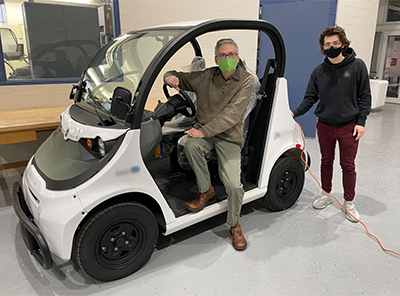Research by Detroit Mercy professor, student shows electrician need for BEV adoption
 Research conducted by Detroit Mercy Professor of Civil, Architectural and Environmental Engineering Alan Hoback and student Brendan Lubiarz has determined that there needs to be 25% more electricians by 2050 to handle battery-powered electric vehicle (BEV) adoption.
Research conducted by Detroit Mercy Professor of Civil, Architectural and Environmental Engineering Alan Hoback and student Brendan Lubiarz has determined that there needs to be 25% more electricians by 2050 to handle battery-powered electric vehicle (BEV) adoption.
The research, titled “Electrician Demand for Battery Electric Vehicle Charger Installation,” was published as a technical paper by SAE International, formerly known as the Society of Automotive Engineers. The report analyzed human behavior and market projections for BEV adoption to determine the number of electricians needed to support the development of BEV infrastructure.
Hoback and Lubiarz, an Architectural Engineering student from Warren, Mich., surveyed hundreds of homes in southeast Michigan to determine how easily they would be able to install electric vehicle chargers. They also interviewed electricians about installation times for various chargers, and compared the responses to published information on how to estimate construction times.
“Most people want fast chargers, but they are more expensive to buy and install,” Hoback said.
However, costs and installation times aren’t limited to consumers desiring a faster charger. Other factors include location of the charger, electrical grids, new electrical lines and ordinances.
Once the surveying and interviewing were complete, Hoback and Lubiarz created a labor forecast based on the projected total work hours required to install the chargers.
According to the U.S. Bureau of Labor Statistics, employment of electricians is projected to grow 9% between 2020-30. The projections note that more electricians will be required with the growth of alternative power sources, however, Hoback argues that they are not accounting for the sudden need for the installation of BEV chargers.
“Many of these projections neglect to include or mention the need for help installing a charger at home or anywhere else in public,” he said. “If unaddressed, this could cause a massive labor shortage when the work is needed most.”
Lubiarz conducted the research through an Electrical Building Systems honors class with Hoback.
“I’ve been really fortunate to work on a project that can give me a different outlook on my career,” Lubiarz said. “Through this research, I’ve realized how different factors can affect the demand for labor and completely reshape a field.
“This research is important because it identifies a crucial issue while it can still be addressed. If we begin now, programs can be altered before the demand for labor reaches its maximum.”
To counter the need for electricians to support BEV infrastructure, Hoback and Lubiarz’s conclusion suggests altering training and education programs.
“Becoming even an apprentice electrician is a lengthy process that discourages many potential workers, who may be interested in the other benefits if the training time is reduced,” Hoback said. “Until we develop a more attractive training program, it will be a constant struggle to maintain the current number of electricians, let alone grow them.”
Learn more about Detroit Mercy's College of Engineering & Science.
— By Ricky Lindsay. Follow Detroit Mercy on Facebook, Twitter and Instagram. Have a story idea? Let us know by submitting your idea.
